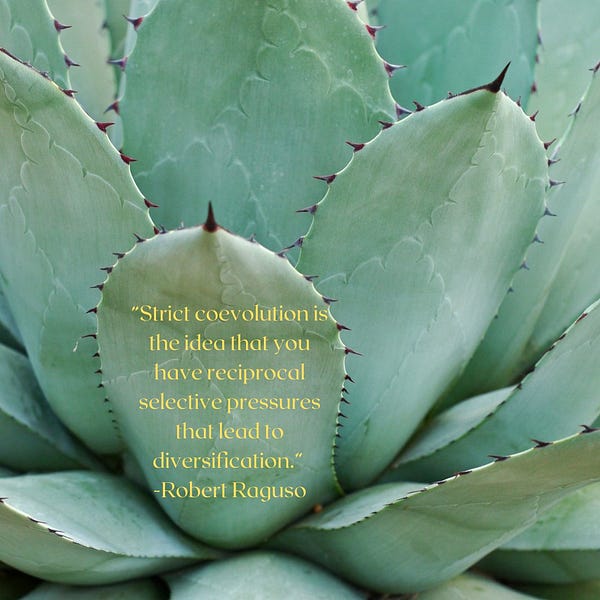Georgia O’Keeffe and the Red Queen: ecosystem services via coevolution with Rob Raguso
Episode 57 // Released February 11, 2020
SUMMARY
On this episode of Big Biology, Robert Raguso from Cornell explains what coevolution is, where did the Red Queen hypothesis come from, and what are the ecosystem services generated through insect plant coevolution
A seminal paper by Paul Ehrlich and Peter Raven in 1964 laid the foundation for the study of coevolution.
Coevolution is the process of reciprocal evolution where traits of one species have evolved in direct response to the traits of its interacting species.
Night blooming flowers and their long-tongued hawkmoth pollinators are a classic example of diffuse coevolution where entire guilds of species across the world have evolved similar traits: long nectar spurs and equally long hawk moth proboscis.
Coevolutionary interactions between animals and plants generates a suite of ecosystem services that extend beyond agriculture. For example, Frankincense and Myrrh are resins produced by plants to defend themselves from herbivory, however historically these resins were used to perform religious rituals in different cultures.
Popular alcoholic drinks like Tequila and Mezcal are derived from Agave plants that are exclusively pollinated by bats.
Flowers have evolved to attract pollinators, yet they serve as our daily inspiration, have a center stage in our festivals, and are bottled as perfumes.
Listen to the full episode on iTunes or Spotify. You can also find the episode on Big Biology’s website.
RESOURCES
Here are links to a few of the resources we talked about on the episode or used to prepare for the interview:
PAPERS
Ehrlich and Raven in this seminal paper constructed a view of coevolution between butterflies and their host plants. They laid the foundation of community ecology by listing numerous examples of associations between butterfly families and their overlapping host plant families. This paper became the steppingstone for future studies to look at coevolutionary interactions and dynamics in other systems. Evolutionary biologists place this paper in the centerpiece in their discussion of coevolution. In the podcast, we discussed the profound impact this paper had on Rob, Art, and Marty’s career.
In this recent paper Rob explains that the ecosystem services generated by coevolutionary interactions between plant and animals are not limited to food production but extend way beyond in influencing human lives. Some such products of coevolution have had an impact on human history and culture across the globe. Frankincense and Myrrh are resins produced by bark of trees to protect themselves from herbivory. The same resins have been used by humans to alleviate pain, heal wounds and in religious practices across cultures. Tequila and Mezcal are derived from Agave plants which are sustained exclusively through bat pollination. Similarly, night blooming flowers serve as sources of perfumes, but the purpose of those scent bouquets are to attract hawkmoth pollinators from a distance. Flowers are not only sources of perfumes but also used in ceremonial exchanges. They serve as our daily inspiration and artists such as Georgia O’Keeffe have famous paintings of the sacred Datura flower. There are many such products that are outcomes of millions of years of interaction between insects and plants and we are the beneficiaries of this coevolution.
IMAGES
A Bombyllid fly on Cardamime flowers. Bombyllids or bee flies have evolved a long tongue to extract nectar from flowers with long nectar tubes. (picture credit: Robert Raguso)
Greya Pollitella moth on Lithophragma flowers (picture credit: Robert Raguso)
Blooming Oenothera Psammophila (Evening primroses) plants photographed in Southwestern desert (picture credit: Robert Raguso)
Volatile trapping of O. Psammophila (left) and florivory by moth caterpillars (right) (picture credit: Robert Raguso)
Hawk moth Hyles lineata feeding on the columbine flowers of Aquilegia chrysantha (picture credit: Robert Raguso)
Hawk moth Hyles lineata feeding on the columbine flowers of Aquilegia chrysantha (picture credit: Robert Raguso)
MEET THE GUEST
Institution: Cornell University
Area of expertise: Coevolution, Sensory ecology, Plant behavior, Chemical Ecology
QUOTEABLE
“Pollinator-mediated selection by hawk moths and bats gave rise to heavily perfumed “moonflowers” (gardenias and jasmines) with aesthetic appeal to humans, and to immense blooming displays by agave plants, co-opted by humans as a source of tequila and mezcal”


EXTRAS
CONTACT US
Got something to tell us? Send us an email at info@bigbiology.org. You can also reach out on Twitter, Facebook and Instagram.











